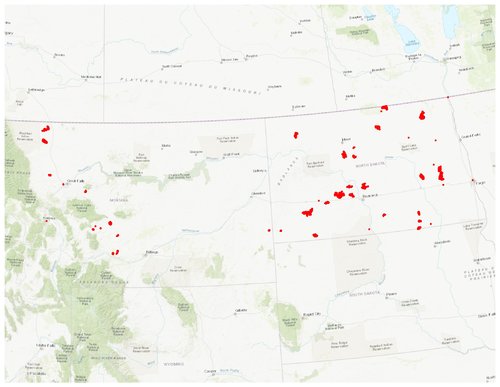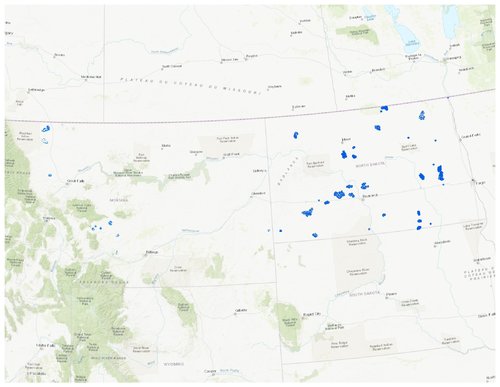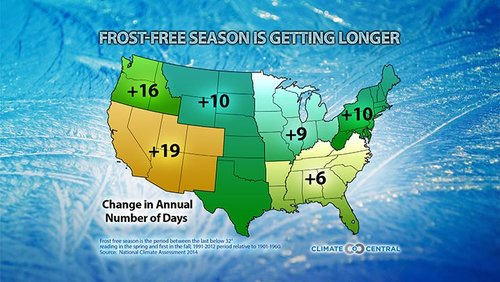Navigation
Install the app
How to install the app on iOS
Follow along with the video below to see how to install our site as a web app on your home screen.
Note: This feature may not be available in some browsers.
More options
You are using an out of date browser. It may not display this or other websites correctly.
You should upgrade or use an alternative browser.
You should upgrade or use an alternative browser.
Time for Land Tawney to step down?
- Thread starter hossblur
- Start date
it's going to be more or less the same as it is today. it sure as hell ain't gonna make no difference to no animals.You don't have a clue what the climate will be like in 100 years, but then turn around and make the assertion that it definitely will have little to no effect on animals or humans...
At least your cluelessness is consistent...
it's going to be more or less the same as it is today. it sure as hell ain't gonna make no difference to no animals.
No difference eh? https://www.sciencedaily.com/releases/2018/10/181017080814.htm
Yea if I upped and quit every organization that took a stance that I didn’t agree with I wouldn’t belong to anyone of them, they all will give you cause especially if looking for an excuse.
If RMEF pushed a bill to limit elk expansion would you stay?
If DU pushed for fewer ducks?
MDF got a bill pushed limiting mule deer?
NWTF calling for less turkeys?
I just missed BHA calling for "public land in developers hands". Guess that rhyme ain't as catchy
I notice the article says,"As winter in New England seems to get warmer".
so winter isn't warmer ,just "seems to be."
that is some serious, but typical, scientific work!
El Jason
Well-known member
Since the thread about the bill in discussion popped up, I have visited several solar projects as part of my job. There isn’t a lot left of the property once the panels are put in. Not to mention, they are fenced.
I disagree with BHA on this, but I’m not surprised. I can show you, and I’ve posted on here before, where the Wilderness Society and Sierra Club have submitted comments in support of establishing exclusion zones inside the Sonoran Desert National Monument for future industrial scale renewable energy development(while in the same comment opportunity advocating for the removal of water sources for wildlife like desert bighorn and mule deer, that sportsmen paid for).
I disagree with BHA on this, but I’m not surprised. I can show you, and I’ve posted on here before, where the Wilderness Society and Sierra Club have submitted comments in support of establishing exclusion zones inside the Sonoran Desert National Monument for future industrial scale renewable energy development(while in the same comment opportunity advocating for the removal of water sources for wildlife like desert bighorn and mule deer, that sportsmen paid for).
D
Deleted member 28227
Guest
@hossblur If you ever get called Muir again just tell'em you're more of a ecofacist like Leopold 
Speaking of Leopold, the Wilderness Society web page is interesting. They support the bill as well, but provide a nuanced of solar development in Nevada.
I would be interested to hear someone from the WS, Land Tawney, and either Rinella or Big Fin discuss this bill and energy development in general. Social media comments don't give you a ton of room to unpack these issues.

 www.wilderness.org
www.wilderness.org
Speaking of Leopold, the Wilderness Society web page is interesting. They support the bill as well, but provide a nuanced of solar development in Nevada.
I would be interested to hear someone from the WS, Land Tawney, and either Rinella or Big Fin discuss this bill and energy development in general. Social media comments don't give you a ton of room to unpack these issues.

Renewable Energy: Lands throughout the Sagebrush State
Big Fin and Teddy Roosevelt IV get into energy development a bit on last week’s podcast@hossblur If you ever get called Muir again just tell'em you're more of a ecofacist like Leopold
Speaking of Leopold, the Wilderness Society web page is interesting. They support the bill as well, but provide a nuanced of solar development in Nevada.
I would be interested to hear someone from the WS, Land Tawney, and either Rinella or Big Fin discuss this bill and energy development in general. Social media comments don't give you a ton of room to unpack these issues.

Renewable Energy: Lands throughout the Sagebrush State
www.wilderness.org
noharleyyet
Well-known member
Is the term global meteorological variance too passive aggressive for market targeting purposes?
BuzzH
Well-known member
View attachment 119629
The number of frost free days IS increasing, and absolutely WILL have an affect on moose populations.
...and people still think you cant grow tomatoes in Laramie. Those 10+ extra days of frost free weather add up.
Woodrow F Call
Active member
We really need people who will look at information and then decide instead of deciding then looking at the information.
There is a mountain of evidence that shows that the climate is changing and the earth is getting warmer. What is in question in the cause of those changes. NASA actually has a good bit of information with the details and discussion on the hows and whys. NASA is made of people from all walks of life and are not just a mouth piece for one side or the other. Some will say it's a government conspiracy, but you can't keep a lid on something with thousands of people in on it. People like to talk.
It is actually well done discussion. https://climate.nasa.gov/
My mind isn't made up on the cause, but just as we impacted Bison and Wolves, we can impact the planet. We have the power to totally destroy it in a few hours or we can pump enough stuff in the atmosphere and take longer. If someone doesn't understand that, they aren't thinking. Look at the improvements from the 1970s smog to now. Big changes for the better.
As far as Solar and Wind, they aren't the total answer. We need power to move our economy and keep us from eating dirt cookies to keep hunger at bay.
As far as BHA, it is probably in their wheelhouse to promote the protection of habitat. It probably doesn't need to be the centerpiece though.
There is a mountain of evidence that shows that the climate is changing and the earth is getting warmer. What is in question in the cause of those changes. NASA actually has a good bit of information with the details and discussion on the hows and whys. NASA is made of people from all walks of life and are not just a mouth piece for one side or the other. Some will say it's a government conspiracy, but you can't keep a lid on something with thousands of people in on it. People like to talk.
It is actually well done discussion. https://climate.nasa.gov/
My mind isn't made up on the cause, but just as we impacted Bison and Wolves, we can impact the planet. We have the power to totally destroy it in a few hours or we can pump enough stuff in the atmosphere and take longer. If someone doesn't understand that, they aren't thinking. Look at the improvements from the 1970s smog to now. Big changes for the better.
As far as Solar and Wind, they aren't the total answer. We need power to move our economy and keep us from eating dirt cookies to keep hunger at bay.
As far as BHA, it is probably in their wheelhouse to promote the protection of habitat. It probably doesn't need to be the centerpiece though.
D
Deleted member 28227
Guest
Is the term global meteorological variance too passive aggressive for market targeting purposes?
I feel triggered.... maybe instead... anthropoid elicited generic conditional divergence
I feel triggered.... maybe instead... anthropoid elicited generic conditional divergence
One word at a time... google dictionary, ftw… You're joining forces with NHY. edumacting me, one word at a time. Then the challenge of putting them together to decipher the meaning of... what?
Im curious.
The funding is discretionary. Which COULD mean, Sanders, or Warren could be installing their secretary.
All the "not a big deal" guys, will it still not be a big deal when you give up your land and hunting areas to fund further wolf expansion. Or grizzly. Or name some "wildlife" cause.
Too often we look through the lense of today.
Giving up land for today's tech, be it wind or solar, is the same as giving it up for yesterday's, like the railroad.
And, Lets face it. Being a renewable company doesn't make you a saint. They want public simply because it's cheaper. If price per acre was the same, no business would ever deal in it because your landlord is the government. It's a lot easier to deal with a single land owner.
Fin And Ted talked about it on the podcast.
Human greed is human greed. Whether it's wearing steel toes and a hard hat, or hemp shirts and birkenstalks doesn't matter.
This post wasn't about climate change. It was about whether the loudest public land group in the West, had been sold out by management in it.
"The largest collection of wealth on the planet"- Fin
And Tawney is good selling it off on the cheap.
The funding is discretionary. Which COULD mean, Sanders, or Warren could be installing their secretary.
All the "not a big deal" guys, will it still not be a big deal when you give up your land and hunting areas to fund further wolf expansion. Or grizzly. Or name some "wildlife" cause.
Too often we look through the lense of today.
Giving up land for today's tech, be it wind or solar, is the same as giving it up for yesterday's, like the railroad.
And, Lets face it. Being a renewable company doesn't make you a saint. They want public simply because it's cheaper. If price per acre was the same, no business would ever deal in it because your landlord is the government. It's a lot easier to deal with a single land owner.
Fin And Ted talked about it on the podcast.
Human greed is human greed. Whether it's wearing steel toes and a hard hat, or hemp shirts and birkenstalks doesn't matter.
This post wasn't about climate change. It was about whether the loudest public land group in the West, had been sold out by management in it.
"The largest collection of wealth on the planet"- Fin
And Tawney is good selling it off on the cheap.
Nameless Range
Well-known member
I'm home from work today, so I thought I'd break up the global warming debate with some GIS.
@Hunting Wife referenced a study on another thread about wind turbines, and their potential effect on breeding ducks. I am not trying to draw any major conclusions, because that is not the nature of one study that simply concludes probabilities using a limited sample size, but it seems to not be controversial to say that wind energy is not so great when in the proximity of riparian duck breeding habitat.
The study looked at riparian areas within 2.5 km of wind turbines and found a 4 -56% reduction in breeding pairs in those areas.
Let's play.
I grabbed a dataset of all the wind turbines in Montana and North Dakota from the US Wind Turbine Database, and buffered them by 2.5 km.

Now, the study referenced wetland and riparian habitat, not all habitat, so I went out and grabbed wetlands GIS data from the USFWS. Using that data, I intersected wetlands with the 2.5 km buffers, and produced a dataset of lands potentially affected by wind turbines under the premises of the study.

Totals:
Montana: 5,658 acres
North Dakota: 56,106 acres
So, under the premises of the study, there are 60,000 + acres between Montana and North Dakota of wetland habitat where we can assume a 4 -56% reduction in duck breeding pairs has already occurred.
I'm not an expert on this and I'm not dying on this hill of science , but a lot of folks would look at those polygons differently if instead of wind turbines, they were something else.
It would be interesting to look at this data further and intersect it with land ownership, but the boy wants his mac and cheese for lunch.
@Hunting Wife referenced a study on another thread about wind turbines, and their potential effect on breeding ducks. I am not trying to draw any major conclusions, because that is not the nature of one study that simply concludes probabilities using a limited sample size, but it seems to not be controversial to say that wind energy is not so great when in the proximity of riparian duck breeding habitat.
The study looked at riparian areas within 2.5 km of wind turbines and found a 4 -56% reduction in breeding pairs in those areas.
Let's play.
I grabbed a dataset of all the wind turbines in Montana and North Dakota from the US Wind Turbine Database, and buffered them by 2.5 km.

Now, the study referenced wetland and riparian habitat, not all habitat, so I went out and grabbed wetlands GIS data from the USFWS. Using that data, I intersected wetlands with the 2.5 km buffers, and produced a dataset of lands potentially affected by wind turbines under the premises of the study.

Totals:
Montana: 5,658 acres
North Dakota: 56,106 acres
So, under the premises of the study, there are 60,000 + acres between Montana and North Dakota of wetland habitat where we can assume a 4 -56% reduction in duck breeding pairs has already occurred.
I'm not an expert on this and I'm not dying on this hill of science , but a lot of folks would look at those polygons differently if instead of wind turbines, they were something else.
It would be interesting to look at this data further and intersect it with land ownership, but the boy wants his mac and cheese for lunch.
Last edited:
Woodrow F Call
Active member
Im curious.
The funding is discretionary. Which COULD mean, Sanders, or Warren could be installing their secretary.
All the "not a big deal" guys, will it still not be a big deal when you give up your land and hunting areas to fund further wolf expansion. Or grizzly. Or name some "wildlife" cause.
Too often we look through the lense of today.
Giving up land for today's tech, be it wind or solar, is the same as giving it up for yesterday's, like the railroad.
And, Lets face it. Being a renewable company doesn't make you a saint. They want public simply because it's cheaper. If price per acre was the same, no business would ever deal in it because your landlord is the government. It's a lot easier to deal with a single land owner.
Fin And Ted talked about it on the podcast.
Human greed is human greed. Whether it's wearing steel toes and a hard hat, or hemp shirts and birkenstalks doesn't matter.
This post wasn't about climate change. It was about whether the loudest public land group in the West, had been sold out by management in it.
"The largest collection of wealth on the planet"- Fin
And Tawney is good selling it off on the cheap.
I agree with not wanting to give public land for the installation of wind turbines or whatever else. IMO, if they want to build a wind turbine, there are plenty of people who will lease you the land. That's one of the drawback to wind turbines, it has a big foot print.
4- 56% seems to be a huge variance in science...basically from not much of a change to a major catastrophe. I would look at the variance and see if the only change in these areas was wind turbines if i was looking at the study. I'm not saying that wind turbines aren't the difference...they may be but if it were the only change, I would contend you would see a consistent change across the board.I'm home from work today, so I thought I'd break up the global warming debate with some GIS.
@Hunting Wife referenced a study on another thread about wind turbines, and their potential effect on breeding ducks. I am not trying to draw any major conclusions, because that is not the nature of one study that simply concludes probabilities using a limited sample size, but it seems to not be controversial to say that wind energy is not so great when in the proximity of riparian duck breeding habitat.
The study looked at riparian areas within 2.5 km of wind turbines and found a 4 -56% reduction in breeding pairs in those areas.
Let's play.
I grabbed a dataset of all the wind turbines in Montana and North Dakota from the US Wind Turbine Database, and buffered them by 2.5 km.
View attachment 119646
Now, the study referenced wetland and riparian habitat, not all habitat, so I went out and grabbed wetlands GIS data from the USFWS. Using that data, I intersected wetlands with the 2.5 km buffers, and produced a dataset of lands potentially affected by wind turbines under the premises of the study.
View attachment 119645
Totals:
Montana: 5,658 acres
North Dakota: 56,106 acres
So, under the premises of the study, there are 60,000 + acres between Montana and North Dakota of wetland habitat where we can assume a 4 -56% reduction in duck breeding pairs has already occurred.
I'm not an expert on this and I'm not dying on this hill of science , but a lot of folks would look at those polygons differently if instead of wind turbines, they were something else.
It would be interesting to look at this data further and intersect it with land ownership, but the boy wants his mac and cheese for lunch.
Similar threads
- Replies
- 100
- Views
- 3K
- Replies
- 137
- Views
- 6K
- Replies
- 2
- Views
- 609
- Replies
- 12
- Views
- 2K






